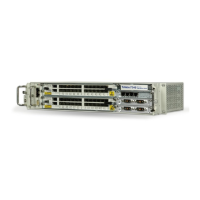6. Maintenance System Manual
Page 2-106 8/09 76.7300FP11/2, Rev A
Fiber Optic Cleaning Requirements
6.27 Fiber optic cleaning procedures should be performed only when a problem
is suspected, when new cables are installed or when existing connections are
removed and replaced.
6.28 To perform the procedures in this section:
__ Observe all electrostatic discharge (ESD) practices, equipment
handling guidelines, and power precautions. To prevent personal
injury, before you perform a particular cleaning task, ensure that you
are familiar with Safety Precautions, page 2-104 and Optical Fiber
Handling, page 2-105.
__ Take traffic into consideration before proceeding with any of the fiber
optic cleaning procedures.
__ Before servicing an in-service system, ensure that traffic has been
removed from the optical interface. This will prevent a service
disruption and ensure that direct exposure to a laser beam is avoided.
__ Inspect the connectors on all new optical interfaces such as fiber
connectors, adapters, and bulkheads before they are used to
complete a connection.
__ Inspect the male and female ends of any connection that is going to be
relocated or reseated.
__ Ensure that dust caps are used to cover all unused types of
connectors including fiber patch cables hanging off fiber racks,
bulkheads on fiber patch panels, and system modules. Keep
connectors covered when not in use.
__ Inspect and clean module (bulkhead) connectors and adapters only if
contamination is suspected.
__ If connectors or adapters are damaged or cannot be cleaned, send
them back to Tellabs for repair.
Caution:
This procedure is service affecting. Before servicing an in-service system, follow
your company's prescribed procedures for obtaining technical assistance, or call
Tellabs Technical Assistance at 1.800.443.5555 (North America) or
1.630.798.7070 (outside North America), before continuing with this procedure.
It is the responsibility of the customer to prevent a service disruption.
DANGER:
Laser emissions on the optical interface may be present. Even if traffic has been
removed when the fiber optic cable was disconnected, the laser associated with
the optical interface of the module may still be on. To avoid personal injury to the
eyes assume the laser is always on and never look into the optical interface on
any module.

